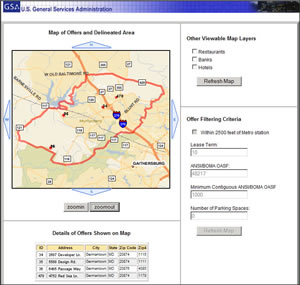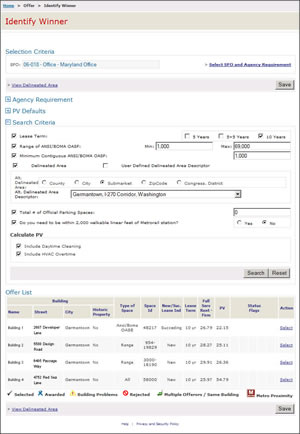GSA Uses GIS to Automate Lease Acquisition and Secure Best Rates
By John Thomas, GSA National Capital Region
The United States General Services Administration (GSA) is responsible for finding workspaces for more than 100 federal client agencies. That often means locating suitable leased space in privately owned buildings. As a paper-based system, AAP did not allow GSA to request new offers or updates from private building owners often enough to reflect the changing real estate market. Lessors could submit offers once a year, then could submit when government-owned space is not available.
In 1991, GSA began the Advanced Acquisition Program (AAP) to consolidate and streamline the leasing process for a large volume of small leases and to procure space faster.
 AAAP geographically identifies the delineated area of the agency space requirement and lease offers on a map. |
As a paper-based system, AAP did not allow GSA to request new offers or updates from private building owners often enough to reflect the changing real estate market. Lessors could submit offers once a year, then could submit an update later in the year. This time lag created situations where lessors would not honor space bids because market rates had increased, or GSA would pay too much for space that had depreciated in value since the bid was submitted. AAP also required GSA managers to manually review an inventory of lease offers, typically in excess of 200 buildings, to determine the lease with the lowest price that met a given agency's requirements such as delineated area, square footage, and term of lease.
Working with Esri; 3T International, Inc. (3TI); and OmniSolve Inc., GSA used geographic information system (GIS) technology to create the Automated AAP (AAAP) online. This allowed an increase in the frequency of offer submissions with real-time pricing.
GIS allows AAAP to automatically identify available buildings that are located within an agency's delineated area and ranks them from lowest to highest price.
Identifying the Best Option
AAAP includes a building owner's offer creation/submission module and the government's offer evaluation module. When creating the offer, a building owner inputs a building address into AAAP, and it is assigned latitude and longitude coordinates and verified in the geographic database (geodatabase). The coordinates are assigned to the offer, and the Esri GIS platform analyzes that data compared to the agency's delineated area requirement.
 With the GIS technology inherent in AAAP, GSA can evaluate, rank, and select lease offers in a matter of seconds. |
GIS also provides information about amenities near an available property including restaurants, retail shops, parking garages, and banks.
This additional information supports GSA in its goal of providing optimal workplace solutions to customer agencies. The GIS-based solution has reduced offer review time from weeks to seconds and improved space delivery for customer agencies.
Outside the government, AAAP helps businesses interact efficiently and effectively with the federal government, provides one-stop access to information, and enables e-commerce.
Advancing E-government
AAAP has advanced the goals of GSA and the President's Management Agenda by establishing itself as the first e-commerce leasing application in the federal government. It also advances these goals by improving the federal government's use of the Web and promoting the use of digital signatures for transactions between the federal government and business.
In addition, AAAP promotes the goals of major administration and congressional priorities such as expanded electronic government per the President's Management Agenda and the Government Paperwork Elimination Act.
GSA rolled out the AAAP campaign in the National Capital Region (NCR) in August 2005. Since that time, GSA NCR has leased more than 526,000 square feet with a contract value worth greater than $118.3 million. The potential exists for AAAP to be deployed in other GSA regions due to its minimal deployment costs. Since it is a Web-based application, such deployment costs would only include an additional server and a data subscription.
GSA estimates its savings from AAAP at $500,000 annually. That is based on the four full-time employees that would have been required to review updated offers 12 times a year, as the AAAP system does, using the old labor-intensive and time-consuming paper-based AAP system.
In October 2006, the benefits of the AAAP application were recognized when it won the 2006 Achievement Award for Real Property Innovation in the asset management category, an award open to all federal agencies that recognizes innovation, creativity, and leading practice in the real property asset management field.
For more information, contact John Thomas at johnd.thomas@gsa.gov. FC